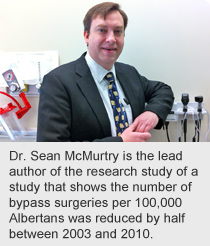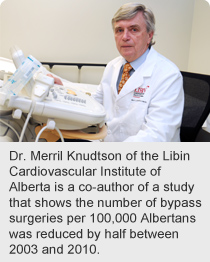
November 16, 2012
Story by Greg Harris; Photo by Paul Rotzinger
Here’s heartening news: the cardiac health of Albertans may be improving, according to a new research study.
 An analysis of cardiac procedures performed across the province from 2003 to 2010 shows the number of coronary artery bypass surgeries in the province fell from 84 per 100,000 people in 2003, to 42 per 100,000 in 2010. The number of cardiac catheterizations, in which a catheter is inserted into an artery or chamber of the heart to assess damage, fell from 480 per 100,000 in 2003 to 430 per 100,000 in 2010.
An analysis of cardiac procedures performed across the province from 2003 to 2010 shows the number of coronary artery bypass surgeries in the province fell from 84 per 100,000 people in 2003, to 42 per 100,000 in 2010. The number of cardiac catheterizations, in which a catheter is inserted into an artery or chamber of the heart to assess damage, fell from 480 per 100,000 in 2003 to 430 per 100,000 in 2010.
“It’s difficult to draw definitive conclusions from the data but they suggest at least two possibilities,” says Dr. Sean McMurtry, lead author of the research study and a cardiologist at the Mazankowski Alberta Heart Institute.
“It may be that many Albertans have reduced their cardiovascular risk factors by quitting smoking, eating better and exercising more. However, medical practice has also changed, with angioplasty being used more frequently as a treatment option than cardiac bypass surgery.”
In angioplasty, a cardiologist inserts a catheter with a special balloon on the end which, when inflated, opens up the fatty deposits clogging the vessel. A stent, or tube, is then usually inserted to help keep the artery open.
Alberta has been maintaining a comprehensive database of information about cardiac procedures since 1995. 
“Ultimately the information helps physicians, administrators and even patients make the most informed decisions they can when it comes to cardiovascular health care,” says study co-author Dr. Merril Knudtson of the Libin Cardiovascular Institute of Alberta.
The paper reports other interesting findings:
The research paper also notes there are geographic differences in the use of cardiac procedures, with northern Alberta consistently having higher rates of use than the provincial average and southern Alberta consistently having lower rates than the provincial average.
“We know that people in the non-urban regions of our province, especially the north, carry a greater burden of risk factors and prevalence of heart disease than the two largest cities,” says Dr. Blair O’Neill, Senior Medical Director of the Cardiovascular Health and Stroke Strategic Clinical Network for Alberta Health Services.
“One of our goals as one health system is to reduce geographic inequities to care. It is reassuring that people living in zones without advanced cardiac facilities appear to have equitable access to cardiac procedures,” Dr. O’Neill adds.
Although the news about apparent improvements in cardiovascular health is encouraging, people still need to pay attention to their own heart health.
“Cardiovascular disease kills thousands of Albertans every year,” Dr. McMurtry says. “It’s encouraging that we may be seeing improvements in the area, but everyone still needs to reduce their risk factors by quitting smoking, eating a healthy diet and getting enough exercise.”